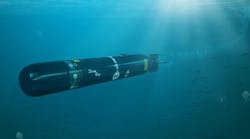Navy researchers survey industry for underwater acoustic projector for LCS torpedo defense
NEWPORT, R.I., 18 April 2013. U.S. Navy underwater warfare experts are surveying industry to find companies with expertise in designing a streamed underwater acoustic projector that will be part of a towed torpedo-countermeasure system to spoof or defeat incoming torpedoes to prevent them from destroying their intended ship targets.
The Naval Undersea Warfare Center (NUWC) in Newport, R.I., issued a sources sought notice Tuesday (N6660413Q0000) for the Streamed Underwater Acoustic Projector for the Lightweight Tow torpedo countermeasure system torpedo defense program to keep U.S. and allied ships safe from torpedo attack.
A streamed underwater acoustic projector would be towed behind ships at a safet distance and transmit ship-like sounds to create false sound signatures to fool incoming torpedoes and divert them from their intended targets. Modern torpedoes have active sonar systems to home in on ships and submarines.
A streamed underwater acoustic projector would be part of the Towed Acoustic Counter Measure (TACM) portion of the Lightweight Tow (LWT) torpedo countermeasure system, which is to be part of the anti-submarine warfare (ASW) mission package of the Navy's littoral combat ship (LCS).
The TACM will be powered by a high-voltage DC source from a ship system, and its acoustic output should be controllable by commands over a fiber optic link. The TACM should be a flexible device that can be deployed, retrieved, and stowed by the Lightweight Tow system.
The TACM be should be as neutrally buoyant as possible, be no longer than 10 feet, and no wider than three inches in diameter. The device should have a minimum deployment and retrieval bend radius less than 10 inches under 250 pounds of tension at a bend angle of 90 degrees.
Acoustic output should be similar to the original AN/SLQ-25C Nixie towed torpedo decoys used on U.S. and allied warships, which emits signals to draw a torpedo away from its intended target, and the TB-14B towed body. A full specification will be part of a future industry solicitation.
Companies interested should submit company and product literature, white papers, and other information, with technical information that describes technology in production, no later than 30 April 2013. Responses should include rough order of magnitude development and manufacturing costs.
Email responses to the Navy's William Thorp at [email protected]. For questions or concerns contact Thorp by email or by phone at 401-832-8608.
More information is online at https://www.fbo.gov/spg/DON/NAVSEA/N66604/N6660413Q0000/listing.html

